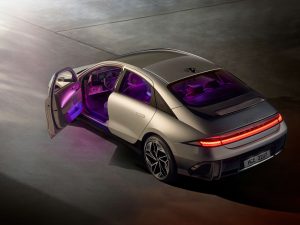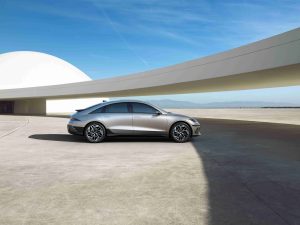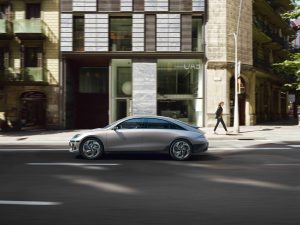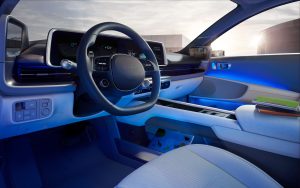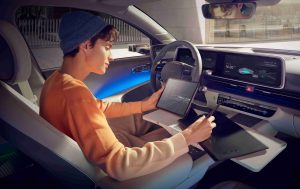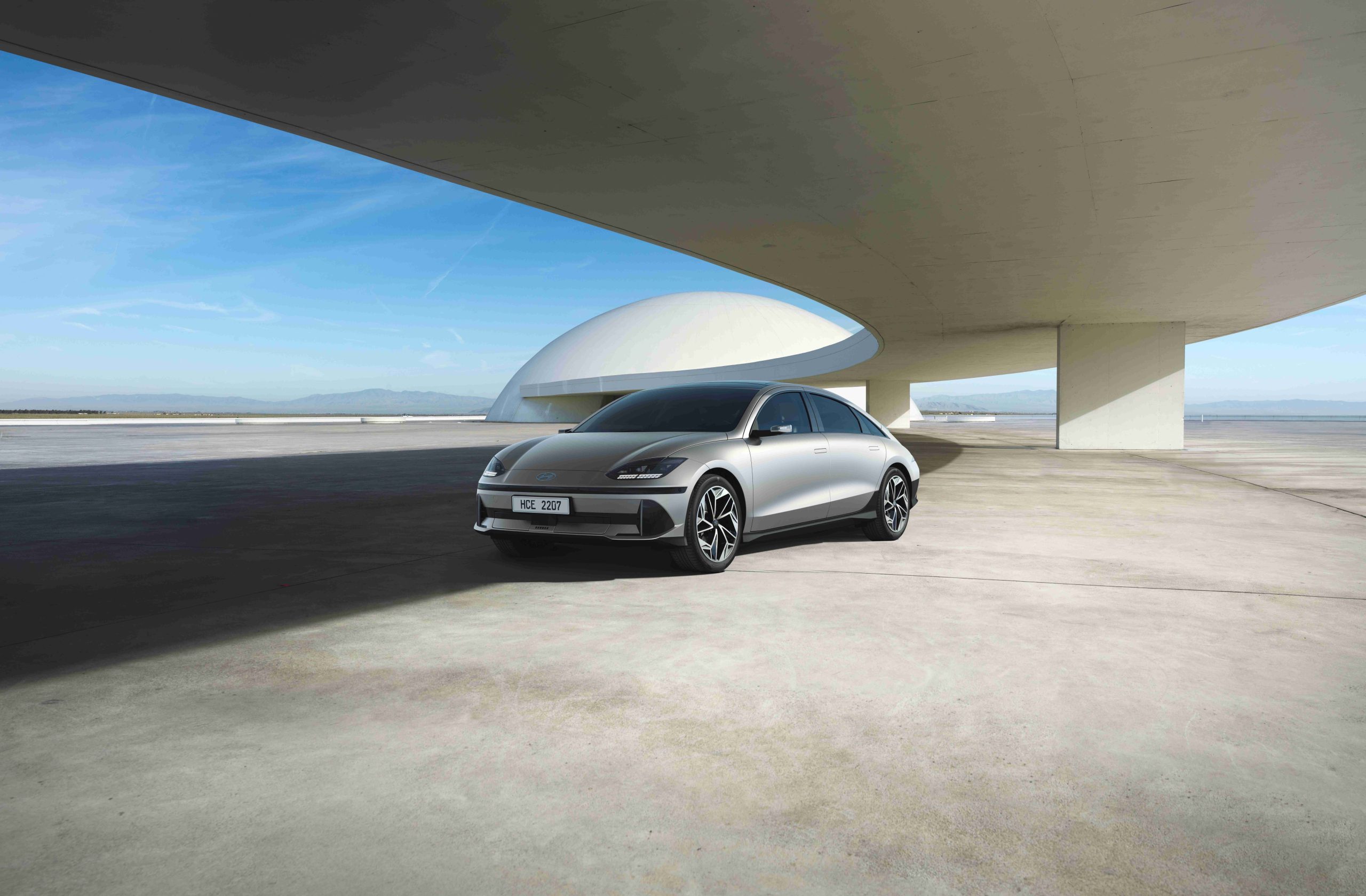

News
Hyundai Ioniq 6 electric sedan unveiling: 340-mile range, 320 horsepower, 77.4kWh battery
Hyundai has unveiled its new all-electric sedan, the Hyundai Ioniq 6.
The Hyundai Ioniq 6 made its first appearance earlier this year, and now the vehicle will be coming to the U.S. in the spring of next year. Today’s unveiling at the LA Auto Show included numerous details about the model coming to the U.S. There is a lot to be excited about.
First of all, the Hyundai Ioniq 6 offers some impressive technical specifications. The sedan has either a single-motor rear-wheel-drive or a dual-motor all-wheel-drive system. The model with the single-motor rear-wheel-drive setup produces a respectable 225 horsepower and 258 pound-feet of torque. While with the Ioniq 6’s optional AWD system, customers get 320 horsepower and 446 pound-feet of torque. An impressive amount of power that will rocket the family sedan from 0-60 in under 5 seconds.
- Credit: Hyundai
Both drivetrains are powered by a 77.4kWh battery that gives the aerodynamic sedan a range of up to 340 miles. And charging the battery will be no problem either, charging from 10-80% in 18 minutes. Sadly, the smaller 53kWh battery sold in other markets will not be available in the U.S. Hyundai didn’t specify an MSRP for any of the upcoming trims at the launch event today.
Outside of just the drivetrain, the Ioniq 6 has a myriad of features, such as vehicle-to-load capability, over-the-air updates, and numerous charge ports sprinkled throughout the cabin to keep your devices topped off.
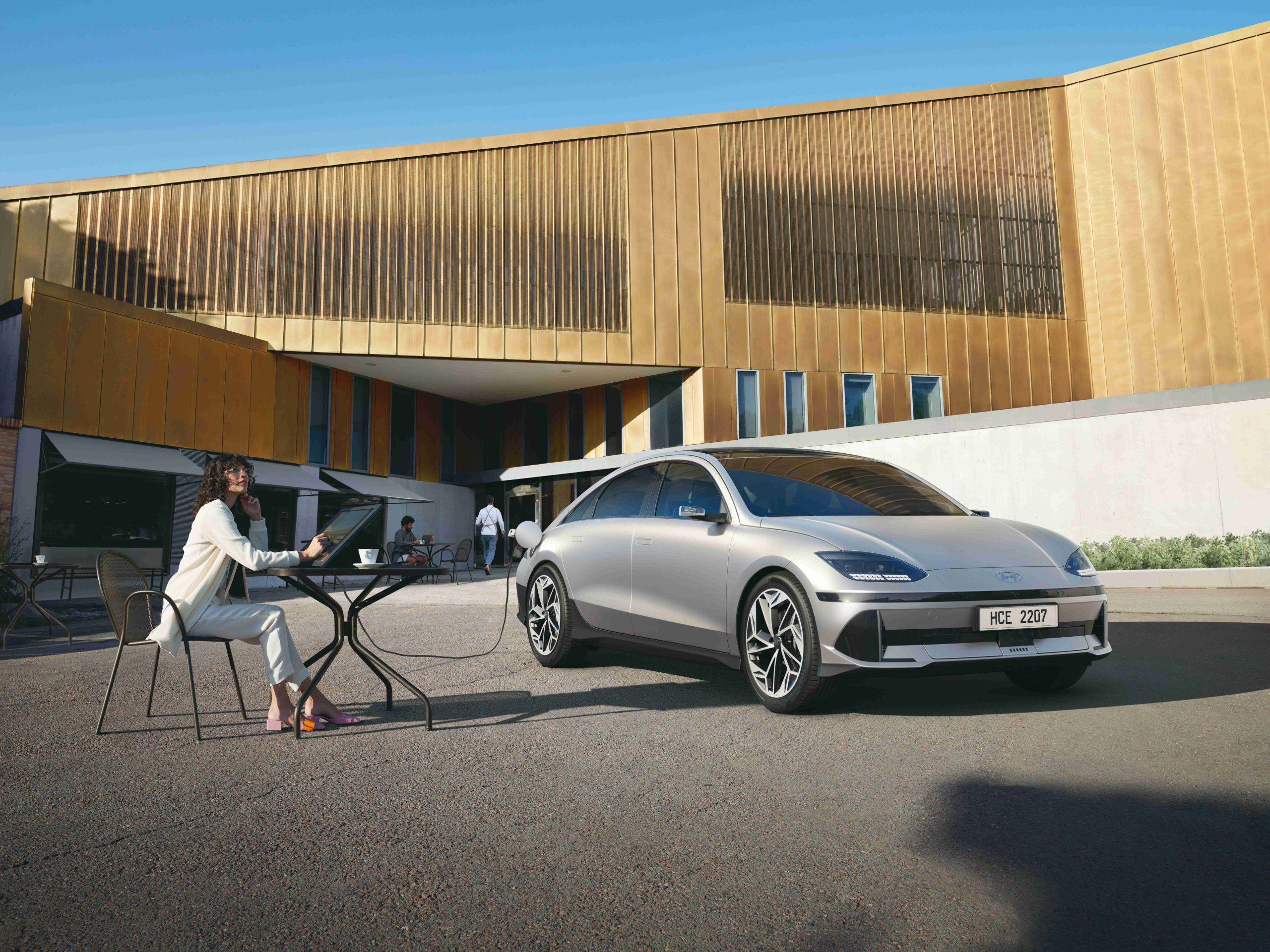
The Hyundai Ioniq 6 has nearly identical specifications to its larger sibling, the Hyundai Ioniq 5, because both vehicles are built on the same “E-GMP” platform. However, with the improved aerodynamics of the Ioniq 6 (a drag coefficient of 0.22), customers have access to increased range with the same battery system.
While impressive, the specifications of the vehicle were not the focus of the unveiling today. Presenters focused on the numerous design elements of the new car and how they affect the occupants’ experience. “We want our cars to always connect with customers on an emotional level,” said SangYup Lee, executive vice president and head of Hyundai Design Center.
First, the sedan’s interior space was a central focus point. Hyundai specifically outlined the significant legroom and width found within the new car. Body panels have been compressed to allow maximum interior space, while the ambient lighting system makes the already spacious cabin feel even more extensive.
The lighting system wasn’t only a selling point for the interior space. Much like the active sound design, the ambient lighting can be set to brighten and dim as the vehicle accelerates and decelerates, only furthering the feeling of speed.
Lighting was also a focus on the exterior design of the Ioniq 6. Hyundai has created a unique design language using square lights, most prominently seen on the headlights and taillights of both the Ioniq 6 and Ioniq 5. These “pixels,” as Hyundai calls them, are added to the top of the Hyundai Ioniq 6’s functional rear wing, and even make their way inside as part of driver-focused U/I elements.
Finally, Hyundai stressed the sustainability focus of its design. Not only was the company dedicated to using “earth-friendly materials,” but it also emphasized that the aerodynamic shape added to the product’s sustainability, helping consumers charge less often and use less energy in their transportation.
In his concluding statements, José Muñoz, president and CEO of Hyundai Motor North America, stated, “[the] Ioniq 6 fits the image, efficiency, and sportiness that many owners desire. Ioniq 6 and its interior space, battery options, charging speed, and all-wheel drive capability will exceed customer expectations.”
After introducing the Ioniq 6 in the spring of next year, it will eventually be produced at Hyundai’s new Georgia-based EV production facility along with numerous other planned products, such as the Hyundai Ioniq 7 full-size SUV that will be coming in 2024.
It is clear that Hyundai has found success with its uniquely designed electric vehicles, and many are looking forward to their Ioniq 6 reservation being filled. It will certainly be an exciting day when the Ioniq 6 finally hits the roads of North America.
Photo Credit: Hyundai Motors North America
What do you think of the article? Do you have any comments, questions, or concerns? Shoot me an email at william@teslarati.com. You can also reach me on Twitter @WilliamWritin. If you have news tips, email us at tips@teslarati.com!

News
Tesla starts showing how FSD will change lives in Europe
Local officials tested the system on narrow country roads and were impressed by FSD’s smooth, human-like driving, with some calling the service a game-changer for everyday life in areas that are far from urban centers.

Tesla has launched Europe’s first public shuttle service using Full Self-Driving (Supervised) in the rural Eifelkreis Bitburg-Prüm region of Germany, demonstrating how the technology can restore independence and mobility for people who struggle with limited transport options.
Local officials tested the system on narrow country roads and were impressed by FSD’s smooth, human-like driving, with some calling the service a game-changer for everyday life in areas that are far from urban centers.
Officials see real impact on rural residents
Arzfeld Mayor Johannes Kuhl and District Administrator Andreas Kruppert personally tested the Tesla shuttle service. This allowed them to see just how well FSD navigated winding lanes and rural roads confidently. Kruppert said, “Autonomous driving sounds like science fiction to many, but we simply see here that it works totally well in rural regions too.” Kuhl, for his part, also noted that FSD “feels like a very experienced driver.”
The pilot complements the area’s “Citizen Bus” program, which provides on-demand rides for elderly residents who can no longer drive themselves. Tesla Europe shared a video of a demonstration of the service, highlighting how FSD gives people their freedom back, even in places where public transport is not as prevalent.
What the Ministry for Economic Affairs and Transport says
Rhineland-Palatinate’s Minister Daniela Schmitt supported the project, praising the collaboration that made this “first of its kind in Europe” possible. As per the ministry, the rural rollout for the service shows FSD’s potential beyond major cities, and it delivers tangible benefits like grocery runs, doctor visits, and social connections for isolated residents.
“Reliable and flexible mobility is especially vital in rural areas. With the launch of a shuttle service using self-driving vehicles (FSD supervised) by Tesla in the Eifelkreis Bitburg-Prüm, an innovative pilot project is now getting underway that complements local community bus services. It is the first project of its kind in Europe.
“The result is a real gain for rural mobility: greater accessibility, more flexibility and tangible benefits for everyday life. A strong signal for innovation, cooperation and future-oriented mobility beyond urban centers,” the ministry wrote in a LinkedIn post.
News
Tesla China quietly posts Robotaxi-related job listing
Tesla China is currently seeking a Low Voltage Electrical Engineer to work on circuit board design for the company’s autonomous vehicles.

Tesla has posted a new job listing in Shanghai explicitly tied to its Robotaxi program, fueling speculation that the company is preparing to launch its dedicated autonomous ride-hailing service in China.
As noted in the listing, Tesla China is currently seeking a Low Voltage Electrical Engineer to work on circuit board design for the company’s autonomous vehicles.
Robotaxi-specific role
The listing, which was shared on social media platform X by industry watcher @tslaming, suggested that Tesla China is looking to fill the role urgently. The job listing itself specifically mentions that the person hired for the role will be working on the Low Voltage Hardware team, which would design the circuit boards that would serve as the nervous system of the Robotaxi.
Key tasks for the role, as indicated in the job listing, include collaboration with PCB layout, firmware, mechanical, program management, and validation teams, among other responsibilities. The role is based in Shanghai.
China Robotaxi launch
China represents a massive potential market for robotaxis, with its dense urban centers and supportive policies in select cities. Tesla has limited permission to roll out FSD in the country, though despite this, its vehicles have been hailed as among the best in the market when it comes to autonomous features. So far, at least, it appears that China supports Tesla’s FSD and Robotaxi rollout.
This was hinted at in November, when Tesla brought the Cybercab to the 8th China International Import Expo (CIIE) in Shanghai, marking the first time that the autonomous two-seater was brought to the Asia-Pacific region. The vehicle, despite not having a release date in China, received a significant amount of interest among the event’s attendees.
Elon Musk
Elon Musk and Tesla AI Director share insights after empty driver seat Robotaxi rides
The executives’ unoccupied tests hint at the rapid progress of Tesla’s unsupervised Robotaxi efforts.

Tesla CEO Elon Musk and AI Director Ashok Elluswamy celebrated Christmas Eve by sharing personal experiences with Robotaxi vehicles that had no safety monitor or occupant in the driver’s seat. Musk described the system’s “perfect driving” around Austin, while Elluswamy posted video from the back seat, calling it “an amazing experience.”
The executives’ unoccupied tests hint at the rapid progress of Tesla’s unsupervised Robotaxi efforts.
Elon and Ashok’s firsthand Robotaxi insights
Prior to Musk and the Tesla AI Director’s posts, sightings of unmanned Teslas navigating public roads were widely shared on social media. One such vehicle was spotted in Austin, Texas, which Elon Musk acknowleged by stating that “Testing is underway with no occupants in the car.”
Based on his Christmas Eve post, Musk seemed to have tested an unmanned Tesla himself. “A Tesla with no safety monitor in the car and me sitting in the passenger seat took me all around Austin on Sunday with perfect driving,” Musk wrote in his post.
Elluswamy responded with a 2-minute video showing himself in the rear of an unmanned Tesla. The video featured the vehicle’s empty front seats, as well as its smooth handling through real-world traffic. He captioned his video with the words, “It’s an amazing experience!”
Towards Unsupervised operations
During an xAI Hackathon earlier this month, Elon Musk mentioned that Tesla owed be removing Safety Monitors from its Robotaxis in Austin in just three weeks. “Unsupervised is pretty much solved at this point. So there will be Tesla Robotaxis operating in Austin with no one in them. Not even anyone in the passenger seat in about three weeks,” he said. Musk echoed similar estimates at the 2025 Annual Shareholder Meeting and the Q3 2025 earnings call.
Considering the insights that were posted Musk and Elluswamy, it does appear that Tesla is working hard towards operating its Robotaxis with no safety monitors. This is quite impressive considering that the service was launched just earlier this year.
